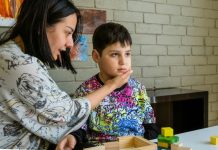
In a new study, researchers found the ability of people with autism to read what someone is feeling or thinking by looking at their eyes and face may have been underestimated.
The research was conducted by a developmental psychology expert from London’s Kingston University.
Autism is a condition that affects social communication and it is widely believed people on the autism spectrum find reading expressions particularly challenging.
Yet a new study by senior lecturer in developmental psychology Dr. Elisa Back, from the University’s Faculty of Business and Social Sciences, suggests this is not always the case.
The findings have important implications for healthcare and education professionals working with children and young people with autism.
The study examined the speed at which adolescents with autism could attribute the correct mental state to faces using videos on a computer and sophisticated eye-tracking equipment.
It also examined the face-processing strategies used by autistic children to identify mental states such as worry or relief and looked at whether they differed from other young people.
A group of 32 adolescents aged between 11 and 16, half of whom had an autism diagnosis, were tested.
The results showed those with autism performed very similarly to those who were typically developing in terms of accuracy, the speed at which they responded and eye movements.
The finding shows that children with autism could recognize mental states from faces as effectively as healthy children.
This is contrary to a considerable amount of previous research, which often contended that children on the autism spectrum had a deficit in this area, or were more impaired than other children.
More research was now needed on how the speed of an expression passing across the face affected the ability of a person with autism to recognize mental states.
The study is published in the American journal Child Development.
Copyright © 2019 Knowridge Science Report. All rights reserved.



